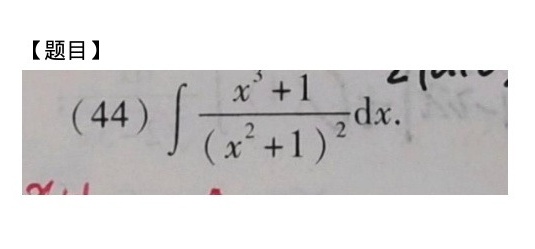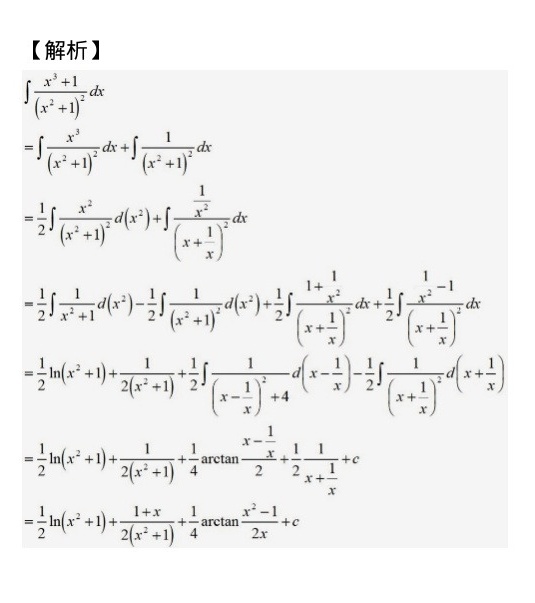题目
(44) int dfrac ({x)^3+1}({({x)^2+1)}^2}dx.

题目解答
答案

解析
步骤 1: 分解被积函数
将被积函数 $\dfrac{{x}^{3}+1}{{({x}^{2}+1)}^{2}}$ 分解为两个部分:$\dfrac{{x}^{3}}{{({x}^{2}+1)}^{2}}$ 和 $\dfrac{1}{{({x}^{2}+1)}^{2}}$。
步骤 2: 对第一部分进行积分
对 $\dfrac{{x}^{3}}{{({x}^{2}+1)}^{2}}$ 进行积分,使用换元法,令 $u = x^2 + 1$,则 $du = 2x dx$,从而 $\dfrac{1}{2}du = x dx$。因此,$\int \dfrac{{x}^{3}}{{({x}^{2}+1)}^{2}}dx = \dfrac{1}{2}\int \dfrac{{x}^{2}}{{({x}^{2}+1)}^{2}}d({x}^{2}) = \dfrac{1}{2}\int \dfrac{u-1}{{u}^{2}}du = \dfrac{1}{2}\int \dfrac{1}{u}du - \dfrac{1}{2}\int \dfrac{1}{{u}^{2}}du = \dfrac{1}{2}\ln|u| + \dfrac{1}{2u} + C_1 = \dfrac{1}{2}\ln({x}^{2}+1) + \dfrac{1}{2({x}^{2}+1)} + C_1$。
步骤 3: 对第二部分进行积分
对 $\dfrac{1}{{({x}^{2}+1)}^{2}}$ 进行积分,使用三角代换法,令 $x = \tan\theta$,则 $dx = \sec^2\theta d\theta$。因此,$\int \dfrac{1}{{({x}^{2}+1)}^{2}}dx = \int \dfrac{\sec^2\theta}{\sec^4\theta}d\theta = \int \cos^2\theta d\theta = \int \dfrac{1+\cos2\theta}{2}d\theta = \dfrac{1}{2}\theta + \dfrac{1}{4}\sin2\theta + C_2 = \dfrac{1}{2}\arctan x + \dfrac{1}{4}\sin(2\arctan x) + C_2$。
步骤 4: 合并结果
将步骤 2 和步骤 3 的结果合并,得到 $\int \dfrac{{x}^{3}+1}{{({x}^{2}+1)}^{2}}dx = \dfrac{1}{2}\ln({x}^{2}+1) + \dfrac{1}{2({x}^{2}+1)} + \dfrac{1}{2}\arctan x + \dfrac{1}{4}\sin(2\arctan x) + C$。
将被积函数 $\dfrac{{x}^{3}+1}{{({x}^{2}+1)}^{2}}$ 分解为两个部分:$\dfrac{{x}^{3}}{{({x}^{2}+1)}^{2}}$ 和 $\dfrac{1}{{({x}^{2}+1)}^{2}}$。
步骤 2: 对第一部分进行积分
对 $\dfrac{{x}^{3}}{{({x}^{2}+1)}^{2}}$ 进行积分,使用换元法,令 $u = x^2 + 1$,则 $du = 2x dx$,从而 $\dfrac{1}{2}du = x dx$。因此,$\int \dfrac{{x}^{3}}{{({x}^{2}+1)}^{2}}dx = \dfrac{1}{2}\int \dfrac{{x}^{2}}{{({x}^{2}+1)}^{2}}d({x}^{2}) = \dfrac{1}{2}\int \dfrac{u-1}{{u}^{2}}du = \dfrac{1}{2}\int \dfrac{1}{u}du - \dfrac{1}{2}\int \dfrac{1}{{u}^{2}}du = \dfrac{1}{2}\ln|u| + \dfrac{1}{2u} + C_1 = \dfrac{1}{2}\ln({x}^{2}+1) + \dfrac{1}{2({x}^{2}+1)} + C_1$。
步骤 3: 对第二部分进行积分
对 $\dfrac{1}{{({x}^{2}+1)}^{2}}$ 进行积分,使用三角代换法,令 $x = \tan\theta$,则 $dx = \sec^2\theta d\theta$。因此,$\int \dfrac{1}{{({x}^{2}+1)}^{2}}dx = \int \dfrac{\sec^2\theta}{\sec^4\theta}d\theta = \int \cos^2\theta d\theta = \int \dfrac{1+\cos2\theta}{2}d\theta = \dfrac{1}{2}\theta + \dfrac{1}{4}\sin2\theta + C_2 = \dfrac{1}{2}\arctan x + \dfrac{1}{4}\sin(2\arctan x) + C_2$。
步骤 4: 合并结果
将步骤 2 和步骤 3 的结果合并,得到 $\int \dfrac{{x}^{3}+1}{{({x}^{2}+1)}^{2}}dx = \dfrac{1}{2}\ln({x}^{2}+1) + \dfrac{1}{2({x}^{2}+1)} + \dfrac{1}{2}\arctan x + \dfrac{1}{4}\sin(2\arctan x) + C$。